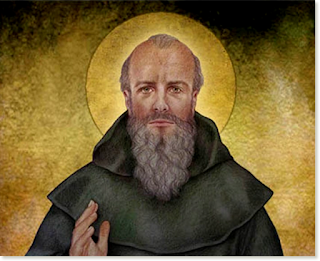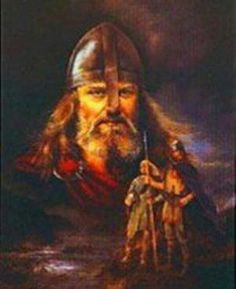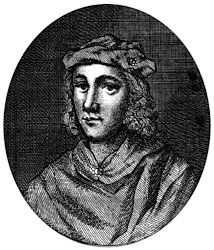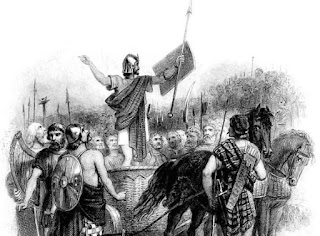Columba's Arrival
Saint Columba
The 9th of June, in 597 AD, was a Sunday. An old man went out into the fields on the island of lona and blessed a barn by making the sign of the cross. The man was Columba. He was 75, and had spent 34 years away from his native Ireland, an 'exile for the love of God.'
The lona monks worked hard in the fields as well as at their prayers. They shipped timber in from the Scottish mainland to build their dormitories. They ploughed and harvested, milked cows, made tools, baked bread, hunted seals for meat, and cut reeds for thatch. Columba was pleased their barn was full of grain and that they would have bread all year.
But for the abbot himself, there was little time left on the island given to him by King Conall. On that Sunday, Columba was preparing to die.
Back home in Donegal, he had been born to wealth and power. In his father's family, immediate kin ruled in the north and relatives ruled in the Irish midlands. The extended family shared the kingship of Tara, and were the most powerful rulers in the northern half of Ireland.
Things were not always peaceful, and one of the violent clashes within this family of warlords and kings had lifelong effects on the middle-aged Columba. A synod considered his alleged actions in giving support to the wrong faction. He was excommunicated and two years later left Ireland for a life of exile in Scotland.
He hadn't always been called Columba (from the Gaelic for dove). His given name was Crimthann, which meant fox. Yet his parents were among the first Christians in that powerful family, and in time their son took a Christian name. They sent him for fosterage and education, not to another powerful nobleman or to a druid, but to a priest called Cruithnechán, then to an aged teacher in the south called Gemmán. And finally, in his twenties when he was a deacon, he became the student of Bishop Finnian in Moville.
This man was one of the leading thinkers about a way of life that swept Britain and Ireland in the first half of the sixth century – the life of retreat, prayer, and community called monasticism. The movement began in the deserts of Egypt and Syria, but when Columba was a boy there were few monasteries in Ireland.
Finnian helped to change that, and his pupil Columba became one of the most famous and influential men in the history of the church, and of monasticism in Ireland and Britain.
lona wasn't his only monastery in Scotland, though it was his first and favourite. A big monastery on Tiree was run by his cousin, Baíthéne. This, too, was a working, farming establishment, but it also took in lay people who had committed great sins and needed advice and healing. They spent seven years on Tiree, in prayer and fasting, atoning for murder, theft, and perjury.
Another of Columba's monasteries was on an island known as 'Hinba' - perhaps Oronsay or Jura, we don't know for sure. Senior monks went there for seclusion and contemplation.
Columba's contemporaries clearly considered him already a citizen of heaven. They reported him bathed in light as he prayed. They reported conversations with angels, and miracles of prophecy and healing.
And so on that Sunday in 597, Columba climbed the small hill of Cnoc nan Cárnan after blessing the grain barn, looked down on his monastery, and said: "On this place, small and mean though it is, not only the kings of the Gaels with their peoples but also the rulers of barbarous and foreign nations, with their subjects, will bestow great and special honour."
He was certainly correct and had himself done much to bring it about. He had many dealings with kings and made many dangerous journeys.
When he went out of the Gaelic colony in Scotland into the lands of the Picts, he needed an interpreter, and his life was threatened, but he also found willing converts to Christianity. He journeyed to the fortress of the Pictish king, Bridei, to get safe passage for his monks, and won the respect and perhaps the conversion of the king.
Such journeys set in motion the gradual conversion of the Pictish nation. Their southern neighbours, the Angles of Northumbria, also saw Columba as their spiritual father. One of their kings, Oswald, had grown up in exile on Iona, and it was to Columba's successors that he turned for missionaries to establish the church in Northumbria.
Columba was a learned man, passionately devoted to the books of the church. All his monks spent time in the scriptorium, copying the psalms and other books of the bible, as well as commentaries on them by scholars like Augustine and Jerome Columba himself gained a great reputation as scholar and teacher as well as copyist-we may even have an example of his work, the manuscript called the Cathach. He also composed hymns, We have at least one of them preserved, a dark and dense celebration of creation, and anticipation of the world's end and the day of judgment.
On his own final day on earth, Columbua repaired from Cnoc nan Carnan, back to the monastery, where he began writing a psalm in a manuscript. This day, however, he stopped part-way through, leaving the rest, as he said, for his kinsman Baithene to finish.
From the writing hut, Columba went to his house to rest, but when the bell for the midnight prayer sounded he raced to the church, sinking on his knees to pray... and to die. His servant Diarmaid reached him first and raised Columba's arm for the last blessing, then the saint was gone, Bathene was left to carry on.
How do we know all this? Almost all the details survive through the work and scholarship of one of Columba's successors and relatives, Adomnán, 9th abbot of lona, who wrote a Life of lona's founder-abbot.
From Columba's roots, lona became a great centre of scholarship Monks, abbots and bishops spent time learning there. Great art followed, too, as manuscripts became more ornately decorated, in works like the Book of Kells.
Adomnan was a worthy successor to Columba. He was a skilled leader and a holy man, a keen diplomat, comfortable with men of power, and able to persuade them to his cause as he freed captives and befriended kings such as the Northumbrian ruler, Aldfrith, his former pupil.
The ninth abbot's most notable diplomatic achievement came in 697 – the centenary of the first abbot's death. Adomnán established a law protecting non-combatants from violence in war and protecting women from violence in all forms, even verbal. To get it enforced, Adomnan gathered guarantees of 50 kings in Ireland and Scotland and 40 leading Gaelic churchmen.
First and foremost, though, Adomnán was a scholar. He wrote a book that became a sort of Rough Guide to the Holy Land for centuries to come. And, of course, he wrote for future generations for us – the Life of Saint Columba.
It celebrates his life and holiness with charm and erudition, and with incidental historical details which bring his distant world to life.
These two men, and the lona monastery they ruled, were vital to the development of Scotland's church, and of Scotland itself.
Centuries after his death, Columba's body, his relics, were sought after for healing and were carried by kings into battle. Their transportation to Dunkeld was one of the founding acts of the new kingdom of Alba, the true parent of the Scottish nation.















Comments
Post a Comment